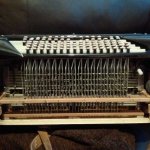Ooh 'eck, that app looks fancy! Unfortunately I have a Blackberry phone, and Linux on the laptop, so I can't use it.
In the meantime, I think we might have confused each other with the voices... I'll try to describe what's happening as best I can.
Treble side:
The voice selector slide only has two positions. With the slide set one way, two or more reeds sound at the same pitch (save for a few cents offset to give that "wet" tone). So play B4, and you'll get multiple reeds all around that note. As an analogy, two or three clarinets playing the same note.
Set the slide the other way, and it plays two notes an octave apart, so play B4 again, and you get both B4 AND B3 playing together. As an analogy, one of the clarinet players has swapped his clarinet for a bassoon. Same with any note you play on the keyboard, you either get two registers (if that's the right term?) in play together, or multiple reeds playing (approximately) the same pitch, depending whether you've got the selector up or down.
(could this be the MM and LM or MMM and LMM I've seen mentioned?)
Bass side:
On single notes, that split over the octave happens automatically on every single individually played note. So play a B on either the root, major 3rd, or minor 3rd row on the bass side, and you'll get a simultaneous high and low B playing, an octave apart. I have no idea how many reeds are playing each, whether it's one high and one low, or two high reeds and two low reeds, or whatever, but you have the same note sounding on two adjacent octaves.
Playing the chords, doesn't play both octaves for each note. It only plays the higher octave of the two. So play a major chord button, and there's only three notes being played. To illustrate this, lets say that a C major chord plays C3, E3, and G3 for example. If you played that chord as an arpegio with the individual buttons, it would play C3 and C2 together, then E3 and E2 together, then G3 and G2 together. You cannot play single notes in only one octave on the bass side.
Depending on where the octave starts and finishes (remembering there's only 12 pallets to open and close on the lower set), you might get an inverted chord on the three chord rows, but you can "force" the root note, by playing the chord and the root note you want at the same time, so that the root note sounds in the lower octave as well. So for example, playing C Major and G, would give G2, C3, E3 and G3, whilst playing C major and E would give E2, C3, E3, and G3.
I hope that's clearer.

